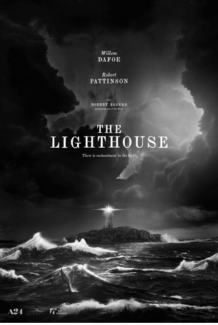The Lighthouse (Robert Eggers, 2019): USA
Reviewed by Larry Gleeson. Viewed at Paseo Nuevos Cinemas.
 Robert Pattinson and Willem Dafoe star as two lightkeepers, Ephraim Winslow and Thomas Wake, trying to survive and maintain their sanity on a mysterious island while living at a remote, New England lighthouse in the 1890s, in The Lighthouse, directed by Robert Eggers (The Witch). Evoking such seafaring literary classics by Herman Mehlville (Moby Dick) and Ernest Hemingway (Old Man and the Sea) as the film opens with an almost square aspect ratio (1.19:1) harkening back to early cinema. The effect is at once claustrophobic and mysteriously out of place.
Robert Pattinson and Willem Dafoe star as two lightkeepers, Ephraim Winslow and Thomas Wake, trying to survive and maintain their sanity on a mysterious island while living at a remote, New England lighthouse in the 1890s, in The Lighthouse, directed by Robert Eggers (The Witch). Evoking such seafaring literary classics by Herman Mehlville (Moby Dick) and Ernest Hemingway (Old Man and the Sea) as the film opens with an almost square aspect ratio (1.19:1) harkening back to early cinema. The effect is at once claustrophobic and mysteriously out of place.
In a traditional narrative fashion, the characters are introduced and established. Winslow, a strapping, mysterious, young man of few words and who appears to have a troubled past claiming a work history as a Canadian lumberjack is the hired help (wickie) under contract for four weeks with hopes of moving up the ladder and someday hoping to become a lighthouse operator like his housemate Wake, a salty, crusty archetypal seaman. Wake comes across as an experienced sea hand with knowledge of sailor life and mythology who has the inexplicable behavior of farting loudly much to Winlow’s chagrin. Moreover, Wake treats Winslow harshly despite Winlsow’s unswerving dedication to carrying out the chores, emptying chamber pots and swabbing the floor repeatedly to Wake’s unending condemnation.
The two work together, sleep together and eat together. Winslow refrains from alcohol until a storm begins pounding the lighthouse. Together the two imbibe, dance, sing and became Marry. Soon, however, a darkness creeps in and the two men vie for control of the lighthouse. Also, Wake refuses Winslow access to the lantern room atop the lighthouse. Intrigued a jealous Winslow begins spying on Wake’s ritualistic time in front of the massive light bulb and becomes infatuated with Wake’s unearthly obsession. The two lighthouse keepers engage in an escalating battle of wills in a tension-fed, trapped scenario with mysterious forces, real or imagined, looming while a seemingly never-ending storm rages outside, leaving the men stranded.
Eggers uses several crew members from The Witch including cinematographer Jarin Blaschke, production designer Craig Lathrop, costume designer Linda Muir, composer Mark Korven, and editor, Louise Ford, to transport the audience into a realm of terrifying unknown. The cinematography is nothing short of spectacular as the lighting and framing create a sense of the paranormal. And, the production design along with the costuming transports the viewer, via the suspension of disbelief, into the time of the 1890s capturing the harshness of the film’s setting. Furthermore, Pattinson and DaFoe play off of each other very well. But, in my opinion, the attention to detail with the sound design including foghorn, seagulls, waves, machinery, and furnace, lend strongThis is when the film goes into warp drive credence to the film’s reality.
The stormy night is when the film goes into warp drive and provides a catalyst for all the odd and unusual behavior to come alive and take over the film’s consciousness. Eggers’s use of black and white allows for the utmost effect in facial lines and scene shadowing. These scenes have a supernatural, expressionistic appearance as the film delves into insanity. What emerges is a tragic Greek myth (it begins with a capital P). Highly recommended!
About this entry
You’re currently reading “The Lighthouse (Robert Eggers, 2019): USA,” an entry on Student Film Reviews
- Published:
- 11.04.19 / 10am
- Category:
- Films
16 Comments
Jump to comment form | comments rss [?]